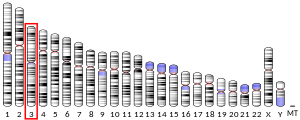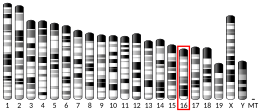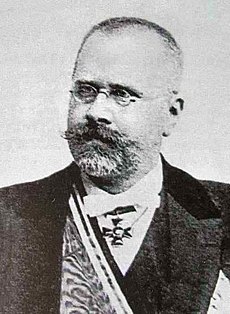도파민 수용체3 D
Dopamine receptor D3도파민 수용체 D는3 인간에게 있어서 DRD3 유전자에 의해 암호화된 단백질이다.[5][6]
이 유전자는 도파민 수용체의 D 아형을3 인코딩한다. D3 하위타입은 억제 G단백질을 통해 아데닐 사이클라아제를 억제한다. 이 수용체는 뇌에서 혈전학적으로 더 오래된 부위로 표현되며, 이 수용체가 인지 및 감정 기능에 역할을 한다는 것을 암시한다.[citation needed] 조현병, 약물중독, 파킨슨병을 치료하는 약의 대상이다.[7] 이 유전자의 대체적인 스플라이싱은 다른 등소형태를 부호화할 수 있는 다중 대본 변형을 야기한다. 비록 일부 변종들은 난센스 매개 부패(NMD)[6]에 노출될 수 있다.
함수
7-OH-DPAT, 프라미펙솔, 로티고틴과 같은 D3 작용제는 설치류 우울증 모델에서 항우울제 효과를 나타낸다.[8][9]
동물학
D원인은3 조현병 등 신경정신과 질환의 센서리모터 게이팅 결손을 재점검하는 이종교배 대책인 '스타틀 사전 억제(PPI)'를 교란하는 것으로 나타났다.[10][11][12] 이와는 대조적으로, D3 선호 길항제들은 랫드의 PPI 측정에서 항정신병 약물 같은 프로파일을 가지고 있다.[13]
리간즈
고민자
- trans-N-{4-[4-[2,3-Dichlorophenyl)-1-피페라지닐]사이클로헥실}-3-메톡시벤츠아미드, 완전작용제, > D4, 5-HT21A 및 α1[14] 수용체에 대한 결합 선택성 200배
- (----7-{[2-(4-페닐피페라진-1-yl)ethylamino}-5,6,7,8-테트라히드로나프탈렌-2-ol[15]
- 5-OH-DPAT
- 7-OH-DPAT
- 페르골라이드[16]
- 8-OH-PBZI(cis-8-Hydroxy-3-(n-propyl)-1,2,3a, 4,5,9b-헥사하이드로-1H-벤츠[e]indole)
- 아포모르핀(비선택성 도파민 작용제)
- 브로모크립틴(비선택성 도파민 작용제)
- 캡토다이메
- CJ-1639[17]
- 복합 R,R-16: D에2[18] 대한 바인딩 선택성 250배
- 도파민 (내생 작용제)
- ES609
- 수도꼭지 54
- 수도꼭지 73
- PD-128,907
- PF-219,061(극히 선택적)
- PF-592,379[20]
- 피리베딜[21](비선택 도파민 작용제)
- 프라미펙솔(비선택적 도파민 작용제)
- 퀴넬로레인(D2 작용제)
- 퀸피롤(D2 작용제)
- 로피니롤(비선택성 도파민 작용제)
- 로티고틴(비선택적 도파민 작용제)
부분작용제
반목자
- 대부분의 항정신병 약물
- Amisulpride(비선택적)
- 키프로헵타딘(비선택적)
- PG 01037 [26][27]
- 돔페리돈(주변 D 및2 D 길항제3)
- 수도꼭지 365, 침묵의 길항제, 하위타입 선택적[25]
- GR-103,691
- GSK598809(고선택적)
- 할로페리돌(비선택적, 가장 강한 친화력을 가진 D3이지만 모든 도파민 수용체 하위 유형을 차단함)
- N-(4-(4-)(4-(2,3-디클로로- 또는 2-메톡시페닐)피페라진-1-yl)부틸)헤테로비릴카르박스아미데스[28]
- 나파도트라이드
- NGB-2904[29]
- PNU-99,194(D2에 비해 선택적)
- 라클로프라이드(D2 길항제)
- S-14,297(선택적)
- S33084
- SB-277011-A, 선택적 D3 길항제, 부분작용제 효과가 없는 D에2 대한 80배 선택성, 여러 가지 다른 약물에 대한 중독의 잠재적 치료제로 약물 중독 연구에 사용
- SR 21502(선택성이 매우 높음)
- 설피라이드(D2 길항제)
- U99194
- YQA14(높은 친화력 및 선택성)
- 리스페리돈
상호작용
도파민 수용체 D는3 CLIC6[30] 및 EPB41L1과 상호작용하는 것으로 나타났다.[31]
참고 항목
참조
- ^ a b c GRCh38: 앙상블 릴리스 89: ENSG00000151577 - 앙상블, 2017년 5월
- ^ a b c GRCm38: 앙상블 릴리스 89: ENSMUSG000022705 - 앙상블, 2017년 5월
- ^ "Human PubMed Reference:". National Center for Biotechnology Information, U.S. National Library of Medicine.
- ^ "Mouse PubMed Reference:". National Center for Biotechnology Information, U.S. National Library of Medicine.
- ^ Le Coniat M, Sokoloff P, Hillion J, Martres MP, Giros B, Pilon C, Schwartz JC, Berger R (September 1991). "Chromosomal localization of the human D3 dopamine receptor gene". Human Genetics. 87 (5): 618–20. doi:10.1007/bf00209024. PMID 1916765. S2CID 28411786.
- ^ a b "Entrez Gene: DRD3 dopamine receptor D3".
- ^ Joyce JN, Millan MJ (February 2007). "Dopamine D3 receptor agonists for protection and repair in Parkinson's disease". Current Opinion in Pharmacology. 7 (1): 100–5. doi:10.1016/j.coph.2006.11.004. PMID 17174156.
- ^ Breuer ME, Groenink L, Oosting RS, Buerger E, Korte M, Ferger B, Olivier B (August 2009). "Antidepressant effects of pramipexole, a dopamine D3/D2 receptor agonist, and 7-OH-DPAT, a dopamine D3 receptor agonist, in olfactory bulbectomized rats". European Journal of Pharmacology. 616 (1–3): 134–40. doi:10.1016/j.ejphar.2009.06.029. PMID 19549514.
- ^ Bertaina-Anglade V, La Rochelle CD, Scheller DK (October 2006). "Antidepressant properties of rotigotine in experimental models of depression". European Journal of Pharmacology. 548 (1–3): 106–14. doi:10.1016/j.ejphar.2006.07.022. PMID 16959244.
- ^ Weber M, Chang WL, Breier M, Ko D, Swerdlow NR (December 2008). "Heritable strain differences in sensitivity to the startle gating-disruptive effects of D2 but not D3 receptor stimulation". Behavioural Pharmacology. 19 (8): 786–95. doi:10.1097/FBP.0b013e32831c3b2b. PMC 3255557. PMID 19020413.
- ^ Chang WL, Swerdlow NR, Breier MR, Thangaraj N, Weber M (June 2010). "Parametric approaches towards understanding the effects of the preferential D3 receptor agonist pramipexole on prepulse inhibition in rats". Pharmacology Biochemistry and Behavior. 95 (4): 473–8. doi:10.1016/j.pbb.2010.04.001. PMC 2889248. PMID 20385162.
- ^ Chang WL, Weber M, Breier MR, Saint Marie RL, Hines SR, Swerdlow NR (February 2012). "Stereochemical and neuroanatomical selectivity of pramipexole effects on sensorimotor gating in rats". Brain Research. 1437: 69–76. doi:10.1016/j.brainres.2011.12.007. PMC 3268831. PMID 22227455.
- ^ Weber M, Chang WL, Durbin JP, Park PE, Luedtke RR, Mach RH, Swerdlow NR (August 2009). "Using prepulse inhibition to detect functional D3 receptor antagonism: effects of WC10 and WC44". Pharmacology Biochemistry and Behavior. 93 (2): 141–7. doi:10.1016/j.pbb.2009.04.022. PMC 2720754. PMID 19426754.
- ^ Leopoldo M, Lacivita E, Colabufo NA, Berardi F, Perrone R (February 2006). "Synthesis and binding profile of constrained analogues of N-[4-(4-arylpiperazin-1-yl)butyl]-3-methoxybenzamides, a class of potent dopamine D3 receptor ligands". The Journal of Pharmacy and Pharmacology. 58 (2): 209–18. doi:10.1211/jpp.58.2.0008. PMID 16451749. S2CID 42910160.
- ^ Biswas S, Zhang S, Fernandez F, Ghosh B, Zhen J, Kuzhikandathil E, Reith ME, Dutta AK (January 2008). "Further structure-activity relationships study of hybrid 7-{[2-(4-phenylpiperazin-1-yl)ethyl]propylamino}-5,6,7,8-tetrahydronaphthalen-2-ol analogues: identification of a high-affinity D3-preferring agonist with potent in vivo activity with long duration of action". Journal of Medicinal Chemistry. 51 (1): 101–17. doi:10.1021/jm070860r. PMID 18072730.
- ^ Perachon, Sylvie; Schwartz, Jean-Charles; Sokoloff, Pierre (February 1999). "Functional potencies of new antiparkinsonian drugs at recombinant human dopamine D1, D2 and D3 receptors". European Journal of Pharmacology. 366 (2–3): 293–300. doi:10.1016/S0014-2999(98)00896-6. PMID 10082211.
- ^ Chen J, Collins GT, Levant B, Woods J, Deschamps JR, Wang S (August 2011). "CJ-1639: A Potent and Highly Selective Dopamine D3 Receptor Full Agonist". ACS Medicinal Chemistry Letters. 2 (8): 620–625. doi:10.1021/ml200100t. PMC 3224040. PMID 22125662.
- ^ Peglion JL, Poitevin C, Mannoury La Cour C, Dupuis D, Millan MJ (April 2009). "Modulations of the amide function of the preferential dopamine D3 agonist (R,R)-S32504: improvements of affinity and selectivity for D3 versus D2 receptors". Bioorganic & Medicinal Chemistry Letters. 19 (8): 2133–8. doi:10.1016/j.bmcl.2009.03.015. PMID 19324548.
- ^ Blagg J, Allerton CM, Batchelor DV, Baxter AD, Burring DJ, Carr CL, Cook AS, Nichols CL, Phipps J, Sanderson VG, Verrier H, Wong S (December 2007). "Design and synthesis of a functionally selective D3 agonist and its in vivo delivery via the intranasal route". Bioorganic & Medicinal Chemistry Letters. 17 (24): 6691–6. doi:10.1016/j.bmcl.2007.10.059. PMID 17976986.
- ^ Collins GT, Butler P, Wayman C, Ratcliffe S, Gupta P, Oberhofer G, Caine SB (June 2012). "Lack of abuse potential in a highly selective dopamine D3 agonist, PF-592,379, in drug self-administration and drug discrimination in rats". Behavioural Pharmacology. 23 (3): 280–91. doi:10.1097/FBP.0b013e3283536d21. PMC 3365486. PMID 22470105.
- ^ Cagnotto A, Parotti L, Mennini T (October 1996). "In vitro affinity of piribedil for dopamine D3 receptor subtypes, an autoradiographic study". European Journal of Pharmacology. 313 (1–2): 63–7. doi:10.1016/0014-2999(96)00503-1. PMID 8905329.
- ^ Spiller K, Xi ZX, Peng XQ, Newman AH, Ashby CR, Heidbreder C, Gaál J, Gardner EL (March 2008). "The selective dopamine D3 receptor antagonists SB-277011A and NGB 2904 and the putative partial D3 receptor agonist BP-897 attenuate methamphetamine-enhanced brain stimulation reward in rats". Psychopharmacology. 196 (4): 533–42. doi:10.1007/s00213-007-0986-6. PMC 3713235. PMID 17985117.
- ^ Chen J, Collins GT, Zhang J, Yang CY, Levant B, Woods J, Wang S (October 2008). "Design, synthesis, and evaluation of potent and selective ligands for the dopamine 3 (D3) receptor with a novel in vivo behavioral profile". Journal of Medicinal Chemistry. 51 (19): 5905–8. doi:10.1021/jm800471h. PMC 2662387. PMID 18785726.
- ^ Dörfler M, Tschammer N, Hamperl K, Hübner H, Gmeiner P (November 2008). "Novel D3 selective dopaminergics incorporating enyne units as nonaromatic catechol bioisosteres: synthesis, bioactivity, and mutagenesis studies". Journal of Medicinal Chemistry. 51 (21): 6829–38. doi:10.1021/jm800895v. PMID 18834111.
- ^ a b Bettinetti L, Schlotter K, Hübner H, Gmeiner P (October 2002). "Interactive SAR studies: rational discovery of super-potent and highly selective dopamine D3 receptor antagonists and partial agonists". Journal of Medicinal Chemistry. 45 (21): 4594–7. doi:10.1021/jm025558r. PMID 12361386.
- ^ Grundt P, Carlson EE, Cao J, Bennett CJ, McElveen E, Taylor M, Luedtke RR, Newman AH (February 2005). "Novel heterocyclic trans olefin analogues of N-{4-[4-(2,3-dichlorophenyl)piperazin-1-yl]butyl}arylcarboxamides as selective probes with high affinity for the dopamine D3 receptor". Journal of Medicinal Chemistry. 48 (3): 839–48. doi:10.1021/jm049465g. PMID 15689168.
- ^ Mason CW, Hassan HE, Kim KP, Cao J, Eddington ND, Newman AH, Voulalas PJ (June 2010). "Characterization of the transport, metabolism, and pharmacokinetics of the dopamine D3 receptor-selective fluorenyl- and 2-pyridylphenyl amides developed for treatment of psychostimulant abuse". The Journal of Pharmacology and Experimental Therapeutics. 333 (3): 854–64. doi:10.1124/jpet.109.165084. PMC 2879935. PMID 20228156.
- ^ Newman AH, Grundt P, Cyriac G, Deschamps JR, Taylor M, Kumar R, Ho D, Luedtke RR (April 2009). "N-(4-(4-(2,3-dichloro- or 2-methoxyphenyl)piperazin-1-yl)butyl)heterobiarylcarboxamides with functionalized linking chains as high affinity and enantioselective D3 receptor antagonists". Journal of Medicinal Chemistry. 52 (8): 2559–70. doi:10.1021/jm900095y. PMC 2760932. PMID 19331412.
- ^ Xi ZX, Gardner EL (2007). "Pharmacological actions of NGB 2904, a selective dopamine D3 receptor antagonist, in animal models of drug addiction". CNS Drug Reviews. 13 (2): 240–59. doi:10.1111/j.1527-3458.2007.00013.x. PMC 3771110. PMID 17627675.
- ^ Griffon N, Jeanneteau F, Prieur F, Diaz J, Sokoloff P (September 2003). "CLIC6, a member of the intracellular chloride channel family, interacts with dopamine D(2)-like receptors". Brain Research. Molecular Brain Research. 117 (1): 47–57. doi:10.1016/S0169-328X(03)00283-3. PMID 14499480.
- ^ Binda AV, Kabbani N, Lin R, Levenson R (September 2002). "D2 and D3 dopamine receptor cell surface localization mediated by interaction with protein 4.1N". Molecular Pharmacology. 62 (3): 507–13. doi:10.1124/mol.62.3.507. PMID 12181426.
추가 읽기
- Missale C, Nash SR, Robinson SW, Jaber M, Caron MG (January 1998). "Dopamine receptors: from structure to function". Physiological Reviews. 78 (1): 189–225. doi:10.1152/physrev.1998.78.1.189. PMID 9457173.
- Sidhu A, Niznik HB (November 2000). "Coupling of dopamine receptor subtypes to multiple and diverse G proteins". International Journal of Developmental Neuroscience. 18 (7): 669–77. doi:10.1016/S0736-5748(00)00033-2. PMID 10978845. S2CID 21002590.
- Sokoloff P, Giros B, Martres MP, Bouthenet ML, Schwartz JC (September 1990). "Molecular cloning and characterization of a novel dopamine receptor (D3) as a target for neuroleptics". Nature. 347 (6289): 146–51. doi:10.1038/347146a0. PMID 1975644. S2CID 4284114.
- Giros B, Martres MP, Sokoloff P, Schwartz JC (1991). "[Gene cloning of human dopaminergic D3 receptor and identification of its chromosome]". Comptes Rendus de l'Académie des Sciences, Série III. 311 (13): 501–8. PMID 2129115.
- Liu K, Bergson C, Levenson R, Schmauss C (November 1994). "On the origin of mRNA encoding the truncated dopamine D3-type receptor D3nf and detection of D3nf-like immunoreactivity in human brain". The Journal of Biological Chemistry. 269 (46): 29220–6. doi:10.1016/S0021-9258(19)62033-8. PMID 7961889.
- Schmauss C, Haroutunian V, Davis KL, Davidson M (October 1993). "Selective loss of dopamine D3-type receptor mRNA expression in parietal and motor cortices of patients with chronic schizophrenia". Proceedings of the National Academy of Sciences of the United States of America. 90 (19): 8942–6. Bibcode:1993PNAS...90.8942S. doi:10.1073/pnas.90.19.8942. PMC 47477. PMID 8415635.
- Griffon N, Crocq MA, Pilon C, Martres MP, Mayerova A, Uyanik G, Burgert E, Duval F, Macher JP, Javoy-Agid F, Tamminga CA, Schwartz JC, Sokoloff P (February 1996). "Dopamine D3 receptor gene: organization, transcript variants, and polymorphism associated with schizophrenia". American Journal of Medical Genetics. 67 (1): 63–70. doi:10.1002/(SICI)1096-8628(19960216)67:1<63::AID-AJMG11>3.0.CO;2-N. PMID 8678117.
- Staley JK, Mash DC (October 1996). "Adaptive increase in D3 dopamine receptors in the brain reward circuits of human cocaine fatalities". The Journal of Neuroscience. 16 (19): 6100–6. doi:10.1523/JNEUROSCI.16-19-06100.1996. PMC 6579196. PMID 8815892.
- Chen CH, Liu MY, Wei FC, Koong FJ, Hwu HG, Hsiao KJ (February 1997). "Further evidence of no association between Ser9Gly polymorphism of dopamine D3 receptor gene and schizophrenia". American Journal of Medical Genetics. 74 (1): 40–3. doi:10.1002/(SICI)1096-8628(19970221)74:1<40::AID-AJMG9>3.0.CO;2-Z. PMID 9034004.
- Gulcher JR, Jónsson P, Kong A, Kristjánsson K, Frigge ML, Kárason A, Einarsdóttir IE, Stefánsson H, Einarsdóttir AS, Sigurthoardóttir S, Baldursson S, Björnsdóttir S, Hrafnkelsdóttir SM, Jakobsson F, Benedickz J, Stefánsson K (September 1997). "Mapping of a familial essential tremor gene, FET1, to chromosome 3q13". Nature Genetics. 17 (1): 84–7. doi:10.1038/ng0997-84. PMID 9288103. S2CID 1506516.
- Oldenhof J, Vickery R, Anafi M, Oak J, Ray A, Schoots O, Pawson T, von Zastrow M, Van Tol HH (November 1998). "SH3 binding domains in the dopamine D4 receptor" (PDF). Biochemistry. 37 (45): 15726–36. doi:10.1021/bi981634+. PMID 9843378.
- Cargill M, Altshuler D, Ireland J, Sklar P, Ardlie K, Patil N, Shaw N, Lane CR, Lim EP, Kalyanaraman N, Nemesh J, Ziaugra L, Friedland L, Rolfe A, Warrington J, Lipshutz R, Daley GQ, Lander ES (July 1999). "Characterization of single-nucleotide polymorphisms in coding regions of human genes". Nature Genetics. 22 (3): 231–8. doi:10.1038/10290. PMID 10391209. S2CID 195213008.
- Pilla M, Perachon S, Sautel F, Garrido F, Mann A, Wermuth CG, Schwartz JC, Everitt BJ, Sokoloff P (July 1999). "Selective inhibition of cocaine-seeking behaviour by a partial dopamine D3 receptor agonist". Nature. 400 (6742): 371–5. doi:10.1038/22560. PMID 10432116. S2CID 4351316.
- Ilani T, Ben-Shachar D, Strous RD, Mazor M, Sheinkman A, Kotler M, Fuchs S (January 2001). "A peripheral marker for schizophrenia: Increased levels of D3 dopamine receptor mRNA in blood lymphocytes". Proceedings of the National Academy of Sciences of the United States of America. 98 (2): 625–8. doi:10.1073/pnas.021535398. PMC 14638. PMID 11149951.
- Lin R, Karpa K, Kabbani N, Goldman-Rakic P, Levenson R (April 2001). "Dopamine D2 and D3 receptors are linked to the actin cytoskeleton via interaction with filamin A". Proceedings of the National Academy of Sciences of the United States of America. 98 (9): 5258–63. Bibcode:2001PNAS...98.5258L. doi:10.1073/pnas.011538198. PMC 33197. PMID 11320256.
- Oldenhof J, Ray A, Vickery R, Van Tol HH (June 2001). "SH3 ligands in the dopamine D3 receptor". Cellular Signalling. 13 (6): 411–6. doi:10.1016/S0898-6568(01)00157-7. PMID 11384839.
- Soma M, Nakayama K, Rahmutula D, Uwabo J, Sato M, Kunimoto M, Aoi N, Kosuge K, Kanmatsuse K (January 2002). "Ser9Gly polymorphism in the dopamine D3 receptor gene is not associated with essential hypertension in the Japanese". Medical Science Monitor. 8 (1): CR1-4. PMID 11796958.
외부 링크
- "Dopamine Receptors: D3". IUPHAR Database of Receptors and Ion Channels. International Union of Basic and Clinical Pharmacology.
- 수용체,+도파민+D3 미국 국립 의학 도서관의 의학 과목 제목(MesSH)
이 기사는 공공영역에 있는 미국 국립 의학 도서관의 텍스트를 통합하고 있다.









